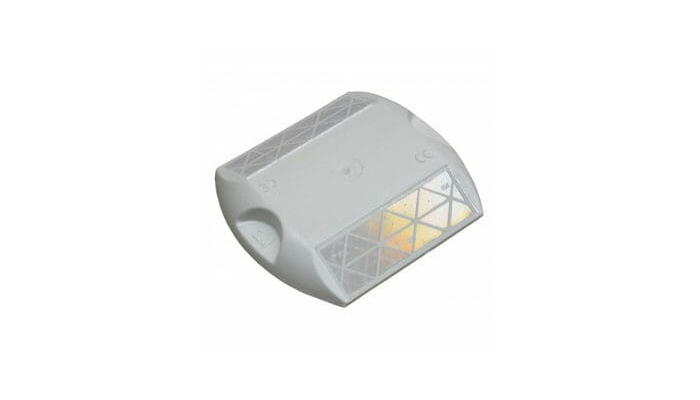
How to Install Raised Pavement Markers Yourself
Raised Pavement Markers (RPMs) are useful devices that improve visibility on roadways by being reflective, which helps drivers navigate safely, especially during bad weather. They not only enhance road safety by clearly marking lanes but also can be a cost-effective solution compared to traditional signage. To install RPMs yourself, you’ll need basic tools like a measuring tape and level as well as materials such as adhesive. First, assess the installation site to make sure it’s clean from debris before marking out where each marker will go. Finally, follow the installation steps carefully while considering safety measures to complete the job effectively. Regular inspections help in maintaining their visibility and effectiveness over time.
Understanding Raised Pavement Markers
Raised Pavement Markers (RPMs) are reflective devices that enhance visibility on roadways, primarily serving to guide drivers during poor weather conditions, such as rain or fog. These markers are designed to improve road safety by clearly delineating lanes, indicating hazards, and marking changes in roadway conditions. RPMs are typically characterized by their reflectivity and height, which make them easily visible both day and night.
Common materials used in manufacturing RPMs include durable plastics and rubber, often designed to withstand tough weather elements. Unlike traditional road markings, which are painted onto the road surface, RPMs stand above the pavement, providing a 3D effect that catches the eye of drivers. The typical colors of RPMs, such as white, yellow, and red, convey specific meanings: for instance, white usually indicates lane boundaries, while yellow often signifies caution or warnings.
RPMs are effective in various weather conditions, as their reflective properties enhance visibility even in low light. Over the years, RPM technology has evolved significantly, with updates in design and materials that improve their longevity and effectiveness. These markers are most commonly found on highways and in urban areas, where traffic management is critical.
Regulatory standards govern the installation and use of RPMs, ensuring that they meet safety requirements. For example, specific guidelines dictate their placement, height, and color to maximize their effectiveness. Case studies from different regions have shown that well-implemented RPMs can lead to reduced accidents and improved traffic flow, highlighting their vital role in modern road safety.

Advantages of Using RPMs
Raised Pavement Markers (RPMs) offer several advantages that enhance road safety and efficiency. One of the most significant benefits is their ability to improve visibility at night, which helps to reduce nighttime accidents. By clearly marking lane boundaries and guiding drivers, RPMs provide crucial information when visibility is compromised. Additionally, RPMs represent a cost-effective solution compared to more extensive traffic management systems, such as elaborate signage or lighting, leading to long-term savings for municipalities and road authorities.
Flexibility is another key feature of RPMs; they can be designed and placed according to various road types and conditions, making them adaptable for different environments. Their durability is notable as well, as RPMs resist wear and tear from weather and traffic, extending their lifespan and reducing the frequency of replacements. This low maintenance requirement means that once installed, they continue to perform effectively with minimal oversight.
In adverse weather conditions, such as rain or fog, RPMs play an important role in guiding drivers, maintaining lane visibility and safety. They can also be integrated with other traffic safety measures, enhancing overall road safety strategies. The installation process is user-friendly, making it accessible for non-professionals, which encourages DIY projects. Furthermore, studies have shown that areas with improved road safety through RPM installation can experience increased property values, highlighting their broader community benefits. Positive feedback from road users and municipalities further underscores the effectiveness of RPMs in improving road safety.
Essential Tools for Installation
To install Raised Pavement Markers (RPMs) effectively, you’ll need a few essential tools. Start with a measuring tape to ensure proper spacing between the markers. A leveling tool is crucial for accurate placement, as it helps make sure each marker is straight and visually aligned. A hammer or mallet will be necessary for securing the RPMs into the pavement. A utility knife can come in handy for cutting any materials that may need trimming.
In addition to the basics, consider having some optional tools on hand, like a drill or saw, which can simplify the installation process, especially if you need to create anchor points or adjust the markers. When it comes to adhesives, choose the right type based on the specific RPMs you’re using; some markers require epoxy, while others may work well with a strong adhesive designed for outdoor use.
Safety is also a priority during installation. Always wear gloves to protect your hands and consider reflective clothing to increase your visibility, especially if you’re working near traffic. Preparing your tools ahead of time can help ensure a smooth installation. Organize them in a way that you can easily access what you need without wasting time searching.
It’s wise to keep backup tools available in case of any equipment failure, which can save you from delays. Many of these tools can be sourced locally and don’t have to break the bank, making your DIY project both cost-effective and efficient.
Preparation Steps for RPMs
Before installing Raised Pavement Markers, conducting a thorough site assessment is crucial. Start by evaluating the area where you plan to install the RPMs, considering factors such as traffic patterns, roadway curves, and nearby signage. A well-placed marker can enhance visibility and guide drivers effectively. Next, ensure the pavement surface is clean. Remove any debris, oils, or moisture that could interfere with adhesion. This step is vital for the longevity of the markers. After cleaning, accurately mark the installation points using chalk or paint. This will help maintain even spacing and alignment, ensuring that the RPMs are visually appealing and functional.
Weather conditions can significantly impact your installation process. Check forecasts and avoid installing RPMs during rain or snow, as these conditions can affect the adhesive’s performance. Also, consider obtaining necessary permits or approvals from local authorities before starting your project. This can prevent any legal issues down the line. Involving community feedback can also be beneficial. Engaging local residents in the decision-making process can lead to better placement choices that reflect community needs.
If you plan to install RPMs at night, ensure you have adequate lighting to maintain visibility. A timeline for your installation process can help you stay organized and efficient. Lastly, create a checklist that includes all preparation steps, ensuring you have everything ready before you begin the installation.
- Step-by-step guide to conducting a site assessment before installation
- Factors to consider when choosing RPM locations, including visibility and traffic flow
- Methods for cleaning the pavement surface effectively
- How to mark installation points accurately for even spacing
- Tips for assessing weather conditions before installation
- Importance of obtaining necessary permits or approvals
- How to involve community feedback in placement decisions
- Considerations for nighttime installation and visibility
- Creating a timeline for the installation process
- Checklist for all preparation steps to ensure readiness
Step-by-Step Installation Guide
To begin, apply the adhesive according to the type of Raised Pavement Marker (RPM) you are using. For standard RPMs, a strong epoxy works best. Ensure you follow the manufacturer’s instructions on how much adhesive to apply, as using too little may not secure the marker properly. Once the adhesive is applied, position the marker on the pavement, aligning it with any existing road features, such as lane lines or curbs, to maintain consistency.
Next, gently tap the marker into place with a hammer or mallet. This ensures the marker is firmly set and creates a solid bond with the pavement. After placing the marker, check the spacing between adjacent markers to ensure they are evenly spaced, typically around 4 to 6 feet apart, depending on local guidelines.
Allow the adhesive to cure fully before allowing traffic over the newly installed markers. Curing times can vary, so refer to the product instructions to avoid premature traffic use. While waiting, inspect your installation area for any potential hazards and keep the site clean.
If you encounter issues, such as markers not adhering properly, ensure the pavement was clean and dry before installation. Document your installation process with notes and photos, as this can be helpful for future maintenance or inspections. After finishing, clean your tools and the work area thoroughly to maintain safety and efficiency.
Finally, conduct a thorough inspection of your newly installed RPMs before reopening the road. Communicate with local traffic authorities to inform them of your completed work and any necessary adjustments to traffic patterns.
Safety Tips During Installation
Wearing the right safety gear is crucial when installing Raised Pavement Markers. Start with a reflective vest to increase your visibility to drivers, especially in low-light conditions. Hard hats can protect against falling debris, while gloves ensure a good grip on tools and materials. Setting up a safe work zone is essential; use traffic cones or barriers to create a clear area where you are working, which helps keep both workers and passing vehicles at a safe distance.
When working near traffic, always remain vigilant. Position your work zone far enough from the road to minimize risks, and consider using flaggers to direct traffic safely around your installation area. Having a first aid kit on-site is a must; it prepares you for any minor injuries that could occur, allowing for quick responses to cuts or scrapes.
Communicating effectively with passing drivers can also enhance safety. Use clear hand signals or signs to indicate that work is in progress, letting drivers know to slow down or change lanes. Managing worker safety is important, especially when handling heavy tools; ensure that everyone knows proper lifting techniques to prevent injuries.
Adverse weather can present additional challenges. If it’s raining, avoid installation until conditions improve, as wet surfaces can lead to slips or improper adhesion of the markers. Keeping the installation area visible is key; consider using additional cones or lights if visibility is low.
To prevent fatigue during long installation sessions, rotate workers regularly. This helps maintain focus and energy levels, reducing the risk of accidents. Finally, consider providing safety training resources for new installers to ensure everyone understands the protocols and practices necessary for a safe working environment.
Maintaining Your RPMs
To keep your Raised Pavement Markers (RPMs) effective, regular inspections are essential. Check for any signs of damage, such as cracks, discoloration, or detachment from the pavement. If you notice that the reflectivity has diminished or that the markers are misaligned, it may be time for repair or replacement. Keeping RPMs clean is also vital for visibility; use a gentle cleaning solution and a soft brush to remove dirt, debris, or snow buildup. If you spot any damaged markers, report them to local authorities promptly, as this helps ensure road safety for everyone. For winter maintenance, be cautious with snow removal; avoid using heavy equipment that could dislodge or damage the RPMs. Documenting all maintenance activities can help track the condition of your markers over time. Schedule periodic checks based on traffic volume, as busier roads may require more frequent inspections. Involving community members can foster a sense of responsibility and promote local engagement in road safety. Be aware of environmental factors, such as extreme temperatures or heavy traffic, that might affect the durability of your RPMs. Lastly, if you need replacement RPMs or materials, check with local suppliers or online resources to ensure you have the right products for your maintenance needs.
Current Trends in RPM Technology
The landscape of Raised Pavement Markers (RPMs) is evolving, reflecting a commitment to sustainability and innovation. Manufacturers are increasingly adopting eco-friendly materials that minimize environmental impact, such as recycled plastics and bio-based compounds. This shift is crucial as communities become more aware of their carbon footprint and seek greener solutions.
In terms of visibility, advancements in reflective technology are noteworthy. New materials enhance light reflection, ensuring that RPMs remain highly visible even in challenging weather conditions, such as rain or fog. This is particularly important as more urban areas face increased traffic and complex road layouts.
Design improvements are also playing a role in reducing environmental impact. Many RPMs are now designed to be more durable and longer-lasting, which decreases the frequency of replacements and the resources needed for production. Smart technology is making its way into RPMs too. Some models now include sensors that collect data on traffic patterns, which can inform road safety measures and traffic management strategies.
Customization is another trend, allowing cities to tailor RPMs to specific needs, such as color-coded markings for different types of lanes. This personalization enhances communication with drivers, making roadways safer.
The integration of data collection in RPM systems is paving the way for smarter urban design. Cities can analyze data from RPMs to identify high-risk areas, improving road safety initiatives. Research studies have shown that these new technologies significantly enhance visibility and contribute to lower accident rates.
Collaborations between manufacturers and urban planners are essential for advancing RPM designs. By working together, they can create solutions that are not only effective but also environmentally responsible. As we look to the future, we can expect continuous advancements in RPM technology, further improving road safety and sustainability.
Final Thoughts on DIY RPM Installation
Installing Raised Pavement Markers (RPMs) yourself can be a rewarding experience. Not only does it save money, but it also contributes to the safety of your community. When you take on this project, you gain valuable skills and a sense of accomplishment. To ensure success, be aware of common pitfalls, such as improper spacing or inadequate surface cleaning, which can lead to ineffective installations. Once you’ve finished, take a moment to celebrate your hard work, whether that means enjoying a small treat or sharing the news with friends and family. You might even consider posting your results on local forums or social media to inspire others. Additionally, educating yourself and your community about road safety measures is essential. Building a network of DIY enthusiasts can provide support and tips for your next project, helping everyone become better installers. Lastly, before you install your RPMs, check your supplies: have the right tools, materials, and safety gear ready. A final checklist ensures you haven’t missed anything, paving the way for a successful installation that can greatly enhance local road safety.
Frequently Asked Questions
What tools do I need to install raised pavement markers?
To install raised pavement markers, you typically need a few basic tools, such as a hammer, a drill with appropriate bits, and a measuring tape. Some people also use a level to ensure proper alignment.
How do I choose the right location for installing the markers?
When choosing a location, look for areas where visibility is crucial, like intersections or high-traffic zones. Make sure to avoid places that could interfere with existing road signs or obstruct views for drivers.
Is it necessary to prepare the road surface before installation?
Yes, it’s important to clean the road surface before installation. Remove any debris, dirt, or oil to ensure that the adhesive will bond well and the markers will stay in place.
How do I ensure the markers are properly aligned?
To ensure proper alignment, measure the distance from other road markings or edges, and use a string line or a level to keep everything straight. Taking your time at this step makes a big difference.
Can I install these markers in different weather conditions?
It’s best to install raised pavement markers in dry weather to allow the adhesive to set properly. Avoid rainy or extremely cold conditions, as they can affect the installation process.
TL;DR Raised Pavement Markers (RPMs) improve road safety by enhancing visibility and guiding drivers during adverse conditions. They are cost-effective, easy to install, and durable. To install RPMs, you need essential tools like a measuring tape, hammer, and adhesive. Prepare by assessing the site, cleaning the surface, and marking installation points. During installation, apply adhesive, position the markers carefully, and allow for curing time. Safety is crucial, so wear gear and create a safe work zone. Regular maintenance checks ensure continued effectiveness. Current trends include eco-friendly materials and advancements in reflective technology.
Resource URL:
https://roadly.ca/3m-raised-pavement-markers-yellow-one-way-yellow-lens-100-ct/



